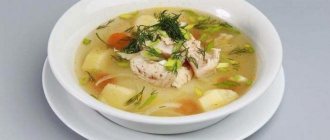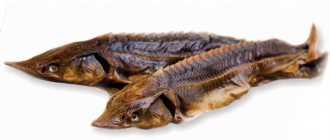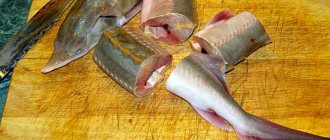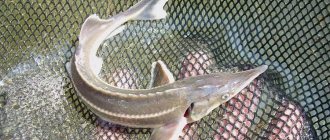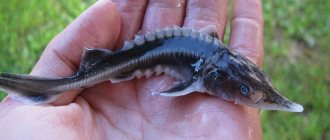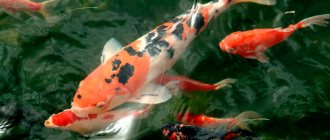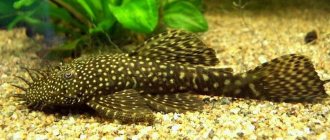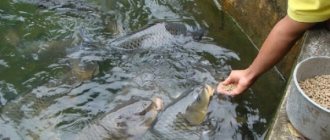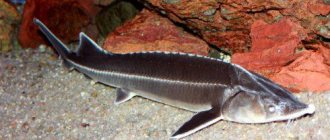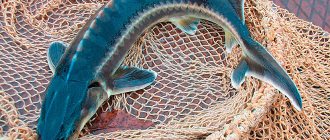You can keep and breed the unpretentious sterlet at home! Moreover, the caviar and meat of this unpretentious fish are incredibly healthy and are highly valued on the market. Having thought through the layout of the aquarium and purchasing fry, the owner will be able to build a profitable business and start selling fish in 5-6 months!
Since ancient times, sterlet has been considered one of the most exquisite fish delicacies. This unique fish belongs to the sturgeon family. The body of the fish reaches up to sixty-five centimeters in length, and its weight can be ten kilograms. There are more individuals, but they are found only in the wild and then quite rarely.
Every year there are fewer and fewer sterlet in the oceans and seas, for this reason, in order to increase the fish population and prevent it from disappearing as a species, they began to grow it in artificial reservoirs both on a domestic and industrial scale.
Some people like to breed sterlet at home for their own pleasure, while others grow it for sale, using this idea as a fairly profitable business.
Containers and equipment for growing sterlet
At the very beginning of breeding this sturgeon breed, you don’t have to build an artificial reservoir, but simply purchase a standard plastic pool one meter deep and two and a half meters in diameter. In a year you can grow up to a ton of sterlet in it.
In order for the fry to grow and develop, the pool must be equipped with filtration and aeration elements, and the container must be cleaned from time to time. For this reason, those who decide to breed sterlet will need to purchase an additional compressor unit, pumps and filters.
If finances allow, it is advisable to buy an automatic feeder. When choosing a compressor and pump, you need to choose units that will process a slightly larger volume of water than you have. This is done to ensure that the equipment does not work at its maximum capacity and lasts as long as possible. Over time, you can buy another pool and significantly expand the farm.
Related species
Despite the fairly large diversity of representatives of the family (dozens of types of sturgeon, stellate sturgeon, thorn, kaluga), all species are biologically very close and allow the formation of unique hybrids.
In 1952, a bester was bred in the USSR, whose name consists of the first syllables of the name of the “parents” - the largest generic taxon of Beluga (Huso huso) and the smallest - Sterlet.
This fish is characterized by tolerance to salt water (up to 18%) and a sharp contrast between the gray-brown or brown back and light belly. The original hybrid incorporated the accelerated growth of beluga and the rapid maturation of sterlet. The maximum weight of a bester reaches 28-30 kg with a body length of 170-180 cm. But these figures can be doubled subject to further crossing with the pure form of Huso huso - the beluga bester. In the basins of the Irtysh, Ob, Yenisei, Angara, Sayano-Shushenskoye and Krasnoyarsk reservoirs, a special subspecies of sturgeon lives - the Siberian sterlet (Acipenser ruthenus marsiglii). This taxon differs from the basic form by late maturation, lighter color and the ability to gain weight over 20 kg.
To learn more:
Bream: description of fish, habitat and habits
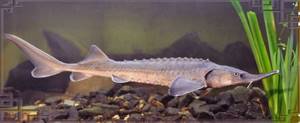
Sterlet food and fry
It is very difficult to breed sterlet fry at home, and without the appropriate equipment and skills it is completely impossible. For this reason, it is best to purchase them from one of the trusted fish farms that grow this breed of sturgeon.
There is no point in saving here, because the better quality and healthier the fry are, the sooner they will grow, which means the breeder will be able to make a good profit. Regarding feed additives for sterlet, there are some peculiarities that must be taken into account when breeding. The food should be the same size as the fish. That is, for small fish - less, and for large individuals - more.
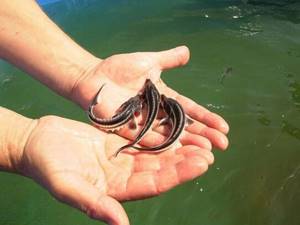
Feed additives for this species of sturgeon should be high in calories and rich in protein, lysine, fat, as well as fiber and phosphorus. The food should contain the most protein and fat.
For this reason, you shouldn’t skimp on food either. It is better to buy it specifically for sterlet, since in this case it will fully meet its needs. Another feature of feeding is strict adherence to temperature. It should reach twenty to twenty-four degrees. This temperature regime must always be maintained in the reservoir, otherwise the fish will not eat well and, accordingly, grow.
Habitat and biology
Sterlet is a potama freshwater species that is rarely found in large lakes. It inhabits the lower reaches and foothills of rivers, usually staying in the area of currents, deep in the river bed. Small individuals are often found in sandy shallow waters.
Spawning areas are located in river beds, at a depth of 7 to 15 meters, or in the area of spring river floods, on gravel and, less often, gravel-sand bottoms. Typically, sterlet is a permanent resident of the river and does not migrate long distances. In nature, males reach sexual maturity at 3-6 years, 1-2 years earlier than females. Stable conditions of the recirculation system, with control of temperature, lighting, feeding regime, significantly accelerate the growth and maturation of fish (up to 2 years). Environmental conditions: temperature – 6 – 29°C; dissolved oxygen concentration - 4.5 - 11.5 mg/l. Oxygen demands directly correlate with temperature.
Features of home breeding of sterlet
The most exciting question for farmers is when will the fish start to grow and become profitable. So how does the fry grow?
Often, five grams of fry are taken for breeding sterlet. They all grow differently. After six months, half of the fish can weigh five hundred grams, while the second half will weigh less, and after a while it will “overtake” its more “well-fed” counterparts in weight.

The most popular product is fish that weighs five hundred grams or more. It is readily accepted by supermarket and restaurant owners. In our country, the consumption of sterlet is not too high, but still, since there is practically no such fish on the market, it sells with a bang. It is for this reason that this type of business is considered very profitable.
After the largest individuals have grown, the smaller ones need several more months to grow. After a month and a half, a medium-sized fish grows, and then smaller ones grow. Already nine months after planting the first batch in the pool, you can load a new one. If breeding goes well, you can purchase several more tanks and expand the farm.
Nutrition
Newly hatched sterlets feed on the contents of their yolk bladder for a couple of weeks. Then they begin to feed independently on ciliates, microscopic crustaceans. Adults, after spawning and the beginning of a decrease in water, appear on the floodplain, where they feed, fattening up lost mass and energy. They devote this time to hunting mosquito larvae and midges. At the same time, they eat so much that they look filled with caviar.
In summer, the diet of this fish, depending on the area and the reservoir, is dominated by mayflies, small yellowish worms, bloodworm larvae, eggs of other fish, amphipods, and caddis flies. By autumn, the fish switches to eating worms and insect larvae. Large fish prefer fish, leeches, and shellfish.
Growing sterlet as a business
You will surprise no one with such a business as growing aquarium fish, but few people realize that at home you can create a real mini-farm for growing sterlet. If you put effort into it, you can make very good money. Where to start building your successful business?
About the benefits of business
Sterlet belongs to the sturgeon family. It is quite simple and unpretentious in content, if you approach it wisely. You can organize your own mini farm even in apartment conditions. This is precisely the first advantage in growing sterlet. But there are the following advantages of this type of business:
- healthy meat and caviar: these products are in great demand on the market and the demand for them is growing every day;
- Sterlet is unpretentious in keeping and therefore even a beginner can understand the peculiarities of its cultivation; to grow this type of sturgeon at home you will not need to spend a lot of money.
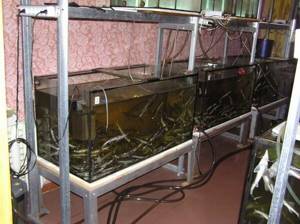
Of all the advantages listed above, one thing can be said is that the sterlet breeding business is quite a profitable activity.
Description of sterlet
The exterior of the fish is distinguished by a triangular body with a thin stalk and a sickle-shaped caudal fin with an elongated upper ray. Other features of the appearance of sterlet include:
- small cone-shaped head;
- elongated narrow nose;
- small lower mouth with bifid lip;
- small bulging eyes;
- fringed antennae;
- lack of scales;
- 5 longitudinal rows of bone scutes (bugs);
- gray dorsal fin moved far back;
- light yellowish-white abdomen;
- ash brown or dark brown color of the ridge.
To distinguish a sterlet from a sturgeon or other members of the family, it is enough to pay attention to the number and arrangement of bony scutes. Acipenser ruthenus is characterized by their tight closure on the back (13-17 pieces). The abdominal 13-15 plates, on the contrary, leave clearly visible gaps between each other. In the lateral line there are many small diamond-shaped bugs adjacent to each other (60-70 pieces), which also make it easy to identify the species among its relatives.
There is a not entirely correct opinion that a sterlet can be distinguished by its elongated, pointed nose. This statement only works on wild and spawn-bearing fish. Cultivated and fattened barren (incapable of reproducing) specimens may also have a shorter snout, like a sturgeon.
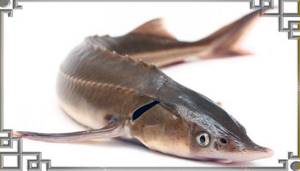
Size and sexual maturity
Despite the high-profile title of the king fish, the sterlet is in fact the smallest representative of the family. The standard weight of adult individuals varies between 1-2 kg with a height of 50-60 cm. Much less often, trophy specimens weighing 4-8 kg are found. The largest weight of a sterlet is 15-16 kg with a body length of 120-125 cm. But there is information about particularly large one and a half meter individuals weighing 20 kilograms or more, caught in the Siberian wilderness on the banks of the Irtysh overgrown with taiga.
To learn more:
Amur catfish - description and characteristics of fish
The relatively small species size determines the accelerated biological cycle of the sterlet (up to 30 years), which becomes sexually mature already in the third to eighth year of life. At the same time, the larger sturgeon, which lives up to 60-70 years, acquires the ability to reproduce only at the age of 8-20 years.
Choosing a place for fish farming
Sterlet can be bred in any conditions. The choice of location will not affect the final result in any way, but only if you follow all the necessary instructions.
If the breeder decides to breed fish in a private house, he must allocate for it a spacious room of thirty square meters, which will be well heated, especially in winter.
In winter, in order for sterlet to grow and develop normally, it must be provided with a temperature of at least seventeen degrees, and in summer the temperature should not fall below twenty degrees. You can also use a polycarbonate greenhouse to grow it, in which you can place a plastic pool.
Place for the fry to live
If the breeder has the necessary capital, then it is best to buy special equipment from the manufacturer. After installation, it can be used immediately, and all the necessary parts will be included.
If you don’t have too much money to purchase equipment, you can create it yourself. To do this, you can use a one-meter plastic pool with a diameter of two to three meters: in it you can grow about a ton of sterlet per year.
Pool equipment
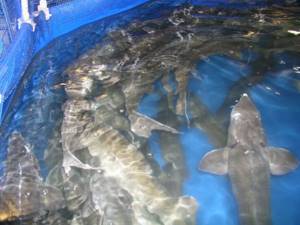
In order to create normal living conditions for fish, the pool must be equipped with aerators, compressors and filters. You will also need pumping equipment as the pool needs to be cleaned. To make it easier to grow sterlet, the pool must be equipped with an automatic feeder. Particular care must be taken when choosing a pump and compressor. It is necessary to buy powerful units, as they will last much longer than their low-power counterparts.
Buying fry
Sterlet breeding begins with the purchase of fry. This is best done in specialized fish farms with a proven reputation. You should not take the first fry you come across; before purchasing them, you need to consult with specialists in order to purchase really high-quality fish that will not die out in a few days.
Choosing the right food
Breeding sterlet is quite simple, the main thing is to choose the right food. Since sterlet prefers to eat at the bottom, it is necessary to buy only food that sinks and smells pleasant, since fish mainly look for it by smell.
Also, the food should not break or crumble in the water. This is important for the sterlet because it does not swallow it immediately, but eats it gradually. In addition, the food should be soft, tasty, high in calories and contain protein, phosphorus, fiber, lysine and fats. With such supplements, fish not only grow well, but also do not get sick.
Lifestyle
Sterlet is a distinct river inhabitant, gravitating towards clean, deep, cool and fast water with plenty of oxygen. Even minor pollution of the environment with chemicals, household waste and elements of agricultural fertilizers can cause significant harm to livestock. Fish have a well-developed schooling instinct, so sterlets form small permanent groups of individuals of the same age, which regularly make short migrations over a distance of several kilometers in search of food. But in general, the sterlet leads a sedentary lifestyle and in nature never moves away from its place of birth. The only exceptions were a few semi-anadromous forms inhabiting the Caspian basin and the Kamchatka River. These fish spend a lot of time on the food-rich, desalinated sea shelf, and to procreate they make long journeys upstream.
Throughout the daylight hours, the sterlet stays at a depth near the bottom and only at dusk moves to shallow water to feed. Food activity persists throughout the warm season and until mid-autumn. In October, sturgeon begin to gather in large schools and migrate to deep sections of the river where wintering pits are located. Thanks to the state of suspended animation, which slows down life processes in the body, fish are able to wait until spring without food and significant weight loss.
What does a sterlet eat?
Small sturgeons are typical benthophages that feed on living organisms living on the bottom of the reservoir. The basis of the sterlet's diet is:
- small crustaceans - daphnia, brine shrimp, amphipods, cyclops, shieldfish;
- larvae - mosquito (bloodworm), dragonfly (naiad), hoverfly, horsefly, soldier fly, honeydew, caddisfly;
- small mollusks – balls, mussels, shutters, coils, lithoglyphs, zebra mussels;
- worms, tubifex, beetles, leeches, water scorpions, bedbugs, paddlefish, smoothies, etc.
To learn more:
Description and characteristics of European grayling
During the season of mass emergence of insects, the fish changes its habits, rises to the very surface, turns over on its back and greedily collects droplets, midges, and butterflies that have fallen into the water.
Where is sterlet found in Russia
The original habitat of the species is the regions of the Russian Federation belonging to Eastern Europe and Western Siberia, including the Yenisei waters. But thanks to increased acclimatization by humans, the sterlet fish now inhabits many rivers in the basins of the Azov, Caspian, Black, Kara, Baltic, Barents and White seas. It is found in the Urals, Ob, Irtysh, Volga, Don, Klyazma, Kama, Vyatka, Dnieper, Dniester, Northern Dvina, Kamchatka, Angara.
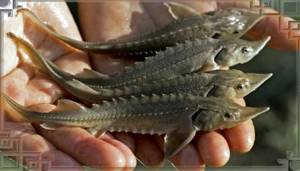
Attempts are regularly made to introduce the taxon into Lakes Ladoga and Onega, Amur, Pechora, Neman and other “free rivers”. But due to the climate and food supply, sterlet does not take root there well and often cannot reproduce on its own.
Growing sterlet in a pond
Breeding sterlet in an apartment or house is quite simple, but still has its drawbacks. For example, these include a small area, maintaining the necessary microclimate, etc. It is much easier to raise fish in a pond.
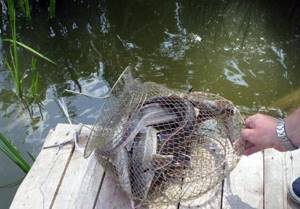
It can be grown both in a ready-made and in a created reservoir. If the pond is old, then before launching the fry, it must be cleaned.
If you create a pond yourself, you must first lime it. To do this, you need to pour a small lime layer on the bottom, fill it with water and rinse thoroughly. This procedure is carried out a couple of weeks before the fish are released.
The bottom is best shaped like a bowl. Don’t forget about algae and various living creatures that the fish will consume. You can also have shellfish in the pond. The best time to start fry is early summer.
Breeding fry
To begin with, larvae are grown, which are formed from fertilized eggs. Then the larvae are released into a ready-made reservoir where there is vegetation so that they can find food there. The larvae should be released when the heat subsides in the late afternoon. They need to be raised in this pond until they are two or four months old, then the fish fry survive in large numbers. The pond where the juvenile fish will be raised is filled with water in advance, at least three days in advance. The water is fertilized with manure, grass clippings and saltpeter. When raising fry, every five days you need to check the composition of the water and for contamination. The fry feed on zooplankton (there should be at least 3 g/m3), they quickly gain weight under favorable conditions.
Sometimes a problem arises about the movement of fry. They need to be transported in water tanks, where there is a sufficient concentration of oxygen and a favorable environment for their transportation. This also needs to be taken into account when breeding fish.
Growing sterlet is a very painstaking job. If you want to have offspring as early as possible, you must maintain favorable conditions for their cultivation. Do not forget that this will require not only time and your effort, but also financial costs.
Population and species status
In the second half of the 20th century, the sterlet had no problems with the population of the species. However, heavy river pollution and illegal hunting have greatly reduced the population. At the moment, sterlet has the status of “vulnerable species” in the international classification. In the Red Book it is marked as “endangered”.
To increase the number, at the beginning of the 19th century, people began to breed sterlet in artificial conditions, and with an abundant increase in the population, they quickly began to use it for commercial purposes.
Now there are a large number of fish farms where this species is grown. Its individuals serve as donors to replenish the number of flocks in certain rivers and for the production of food products.
Interesting: 10 most beautiful fish on the planet - list, names, photos and videos
Special attention is paid to the breeding of sturgeon hybrids. Bester, obtained by merging beluga and sterlet, is very popular.
Social structure
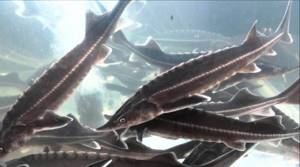
Sterlet lives in large flocks, and the number of individuals can be several hundred. The fish collect food together and try to take care of the young. Perhaps it is precisely thanks to its developed social structure that this species has not only not disappeared from the face of the Earth, but is also increasing its population.
Interesting fact : sterlet is the only representative of sturgeons that live in large groups, and not alone.
When the wintering period begins, the fish together look for a place where they can wait out the cold. Having found a suitable crevice or large depression, the sterlet sinks to the very bottom. Sometimes so many individuals can gather in a ravine at the same time that they cannot even move their fins freely. Then the fish press tightly against each other, fall into suspended animation and become motionless.
Interesting: Moon fish
